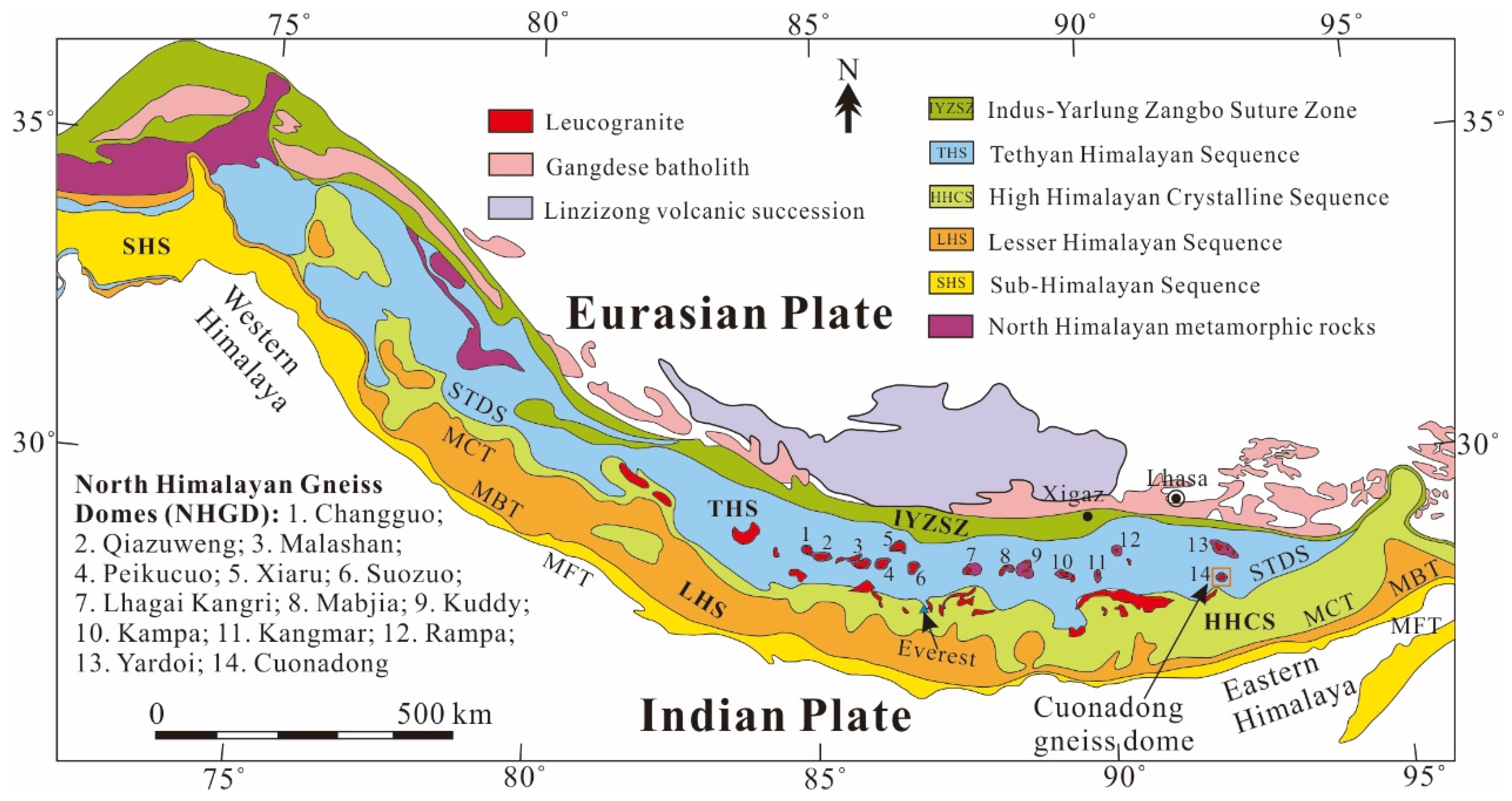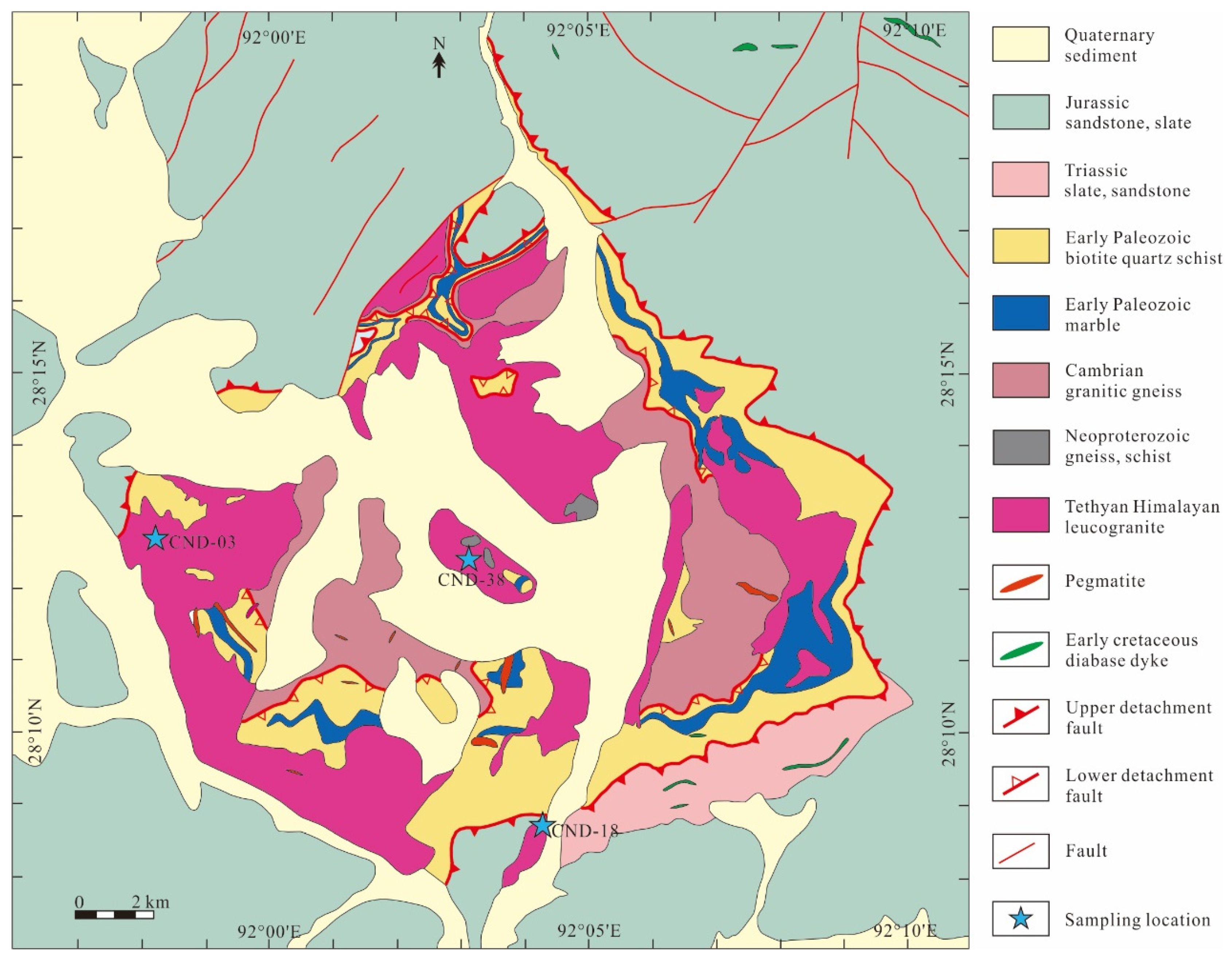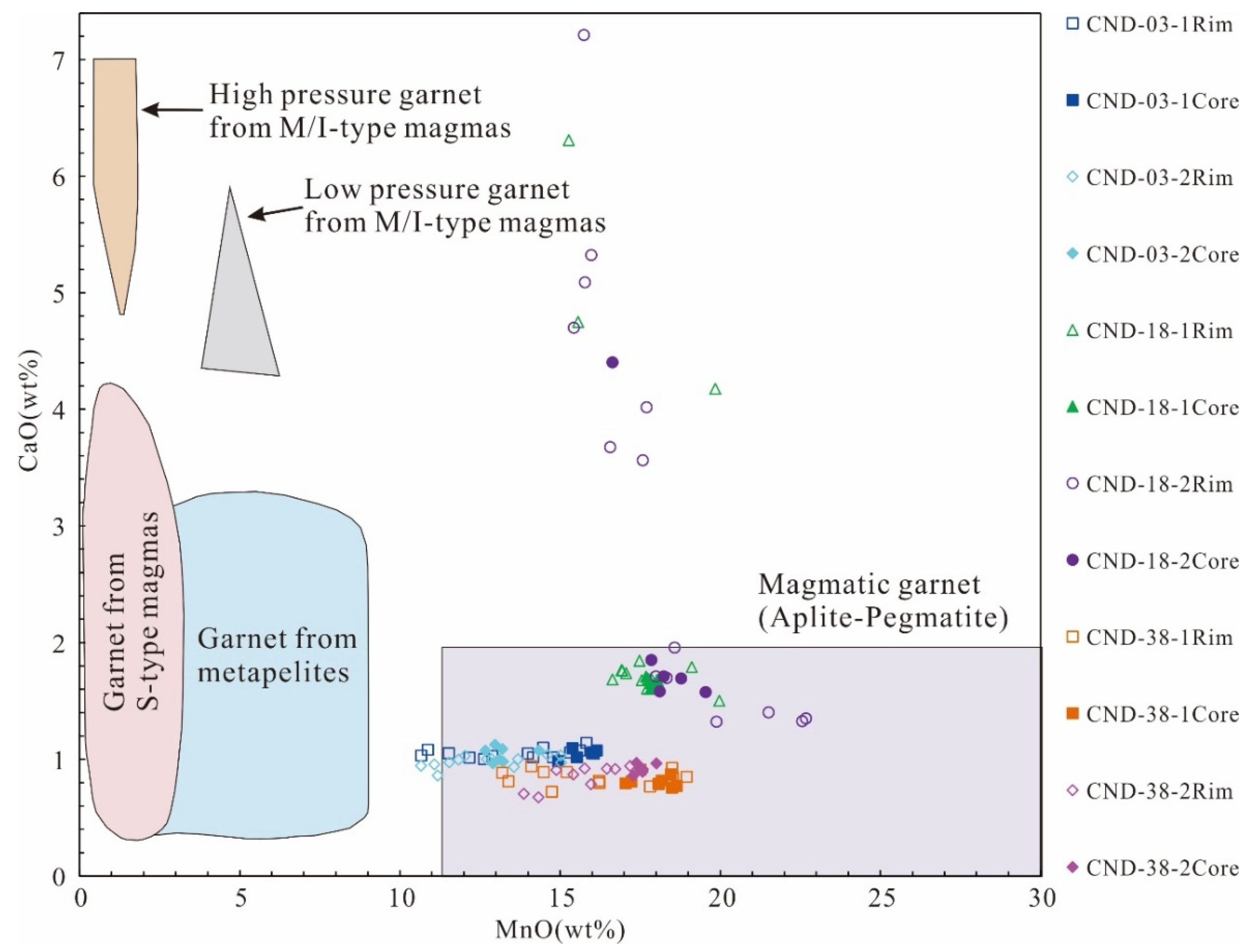Magmatic Garnet and Magma Evolution in Cuonadong Leucogranites: Constraints from Petrology and Mineral Geochemistry
Abstract
1. Introduction
2. Geological Setting
3. Geology of the Cuonadong Dome
4. Samples and Analytical Methods
4.1. Sample Description
4.2. Electron Microprobe Major Element Analysis
4.3. LA–ICP–MS Trace Element Analysis
5. Results
5.1. Major Element Compositions
5.2. Trace and Rare Earth Element Concentrations
5.3. Zoning Textures
6. Discussion
6.1. Chemical Zoning in Garnet
6.2. Origin of Garnet
6.3. P-T Conditions of Garnet Crystallization
6.4. Implications for Evolution Process of Magma
7. Conclusions
- (1)
- The degree of fractionation from the muscovite granite to the pegmatite gradually increases in the Cuonadong dome. Garnets in the muscovite granite and in the pegmatite are dominated by an almandine–spessartine solid solution, and these garnets exhibit Mn, HREE, and Y zonings and are magmatic in origin.
- (2)
- Garnets from the Cuonadong leucogranites formed at moderately low temperatures and relatively low-pressure conditions.
- (3)
- Garnets from the Cuonadong leucogranites are characterized by HREE enrichment and LREE depletion, with significant Eu anomalies. From the muscovite granite to the pegmatite, the contents of HREE and Y in garnets gradually decrease, which indicates the crystallization from a lower-temperature fluid of garnets from the pegmatite. Elevated grossular and CaO contents of the garnet rim from the pegmatite may reflect an influence of fluids in their composition.
- (4)
- Garnet can be used as an indicator of magma evolution in these leucogranites.
Supplementary Materials
Author Contributions
Funding
Data Availability Statement
Conflicts of Interest
References
- Hou, Z.Q.; Zheng, Y.C.; Zeng, L.S.; Gao, L.E.; Huang, K.X.; Li, W.; Li, Q.Y.; Fu, Q.; Liang, W.; Sun, Q.Z. Eocene-Oligocene granitoids in southern Tibet: Constraints on crustal anatexis and tectonic evolution of the Himalayan Orogen. Earth Planet Sci. Lett. 2012, 349–350, 38–52. [Google Scholar] [CrossRef]
- Zheng, Y.C.; Hou, Z.Q.; Fu, Q.; Zhu, D.C.; Liang, W.; Xu, P.Y. Mantle inputs to Himalayan anatexis: Insights from petrogenesis of the Miocene Langkazi leucogranite and its dioritic enclaves. Lithos 2016, 264, 125–140. [Google Scholar] [CrossRef]
- Wu, F.Y.; Liu, Z.C.; Liu, X.C.; Ji, W.Q. Himalayan leucogranite: Petrogenesis and implications to orogenesis and plateau uplift. Acta Petrol. Sin. 2015, 31, 1–36, (In Chinese with English Abstract). [Google Scholar]
- Wu, F.Y.; Liu, X.C.; Liu, Z.C.; Wang, R.C.; Xie, L.; Wang, J.M.; Ji, W.Q.; Yang, L.; Liu, C.; Khanal, G.P.; et al. Highly fractionated Himalayan leucogranites and associated rare-metal mineralization. Lithos 2020, 352–353, 105319. [Google Scholar] [CrossRef]
- Li, G.M.; Zhang, L.K.; Jiao, Y.J.; Xia, X.B.; Dong, S.L.; Fu, J.G.; Liang, W.; Zhang, Z.; Wu, J.Y.; Dong, L.; et al. First discovery and implications of Cuonadong superlarge Be-W-Sn polymetallic deposit in Himalayan metallogenic belt, southern Tibet. Miner. Depos. 2017, 36, 1003–1008, (In Chinese with English Abstract). [Google Scholar]
- Wang, R.C.; Wu, F.Y.; Xie, L.; Liu, X.C.; Wang, J.M.; Yang, L.; Lai, W.; Liu, C. A preliminary study of rare-metal mineralization in the Himalayan leucogranite belts, South Tibet. Sci. China Earth Sci. 2017, 60, 1655–1663. [Google Scholar] [CrossRef]
- Huang, C.M.; Li, G.M.; Zhang, Z.; Liang, W.; Huang, Y.; Zhang, L.K.; Fu, J.G. Petrogenesis of the Cuonadong leucogranite in South Tibet: Constraints from bulk-rock geochemistry and zircon U-Pb dating. Earth Sci. Front. 2018, 25, 182–195, (In Chinese with English Abstract). [Google Scholar]
- Xie, L.; Tao, X.; Wang, R.; Wu, F.; Liu, C.; Liu, X.; Li, X.; Zhang, R. Highly fractionated leucogranites in the eastern Himalayan Cuonadong dome and related magmatic Be-Nb-Ta and hydrothermal Be-W-Sn mineralization. Lithos 2020, 354-355, 105286. [Google Scholar] [CrossRef]
- Cao, H.W.; Li, G.M.; Zhang, R.Q.; Zhang, Y.H.; Zhang, L.K.; Dai, Z.W.; Zhang, Z.; Liang, W.; Dong, S.L.; Xia, X.B. Genesis of the Cuonadong tin polymetallic deposit in the Tethyan Himalaya: Evidence from geology, geochronology, fluid inclusions and multiple isotopes. Gondwana Res. 2021, 92, 72–101. [Google Scholar] [CrossRef]
- Dai, Z.W.; Li, G.M.; Xie, Y.L.; Yang, Z.M.; Marten Huizenga, J.; Liang, W.; Fu, J.G.; Cao, H.W. Source and evolution of the ore-forming fluid of the Cuonadong Sn-W-Be polymetallic deposit (southern Tibet, China): Constraints from scheelite trace element and Sr isotope geochemistry. Ore Geol. Rev. 2022, 142, 104570. [Google Scholar] [CrossRef]
- Zhang, D.C.; Zhang, G.Y.; Chen, X.; Yang, B. Mineralogical characteristics of highly fractionated leucogranite in Cuonadong dome, southern Tibet. Acta Petrol. Mineral. 2021, 40, 1093–1115, (In Chinese with English Abstract). [Google Scholar]
- Orajaka, I.P. Geochemistry of Kaffo Valley albite–riebeckite–granite, Liruei Granite ring-complex, northern Nigeria. Chem. Geol. 1986, 56, 85–92. [Google Scholar] [CrossRef]
- Ben, T.X.; Hoai, N.V.; Visnepskaya, Y.E. The behaviour of rare metals in Piaoac granite massif, Vietnam. J. Southeast Asian Earth Sci. 1993, 8, 383–386. [Google Scholar]
- Huang, D.H.; Wu, C.Y.; Han, J.Z. Petrology, REE geochemistry and rock-forming mechanism of the Zudong and Guangxi granites, Jiangxi Province. Bull. Chin. Acad. Geol. Sci. 1993, 27, 69–94, (In Chinese with English Abstract). [Google Scholar]
- Piccoli, P.; Candela, P.; Rivers, M. Interpreting magmatic processes from accessory phases: Titanite—a small-scale recorder of large-scale processes. Trans. R. Soc. Edinb. Earth Sci. 2000, 91, 257–267. [Google Scholar]
- Wang, R.C.; Hu, H.; Zhang, A.C.; Xu, S.J.; Wang, D.Z. Yttrium zoning in garnet from the Xihuashan granitic complex and its petrological implications. Chin. Sci. Bull. 2003, 48, 1611–1615, (In Chinese with English Abstract). [Google Scholar] [CrossRef]
- Li, X.H.; Li, W.X.; Wang, X.C.; Li, Q.L.; Liu, Y.; Tang, G.Q. Role of mantle-derived magma in genesis of early Yanshanian granites in the Nanling Range, South China: In situ zircon Hf-O isotopic constraints. Sci. China Ser. D Earth Sci. 2009, 52, 1261–1278, (In Chinese with English Abstract). [Google Scholar] [CrossRef]
- Yang, J.H.; Peng, J.T.; Hu, R.Z.; Bi, X.W.; Zhao, J.H.; Fu, Y.Z.; Shen, N.P. Garnet geochemistry of tungsten-mineralized Xihuashan granites in South China. Lithos 2013, 177, 79–90. [Google Scholar] [CrossRef]
- Dutrow, B.L.; Henry, D.J. Tourmaline compositions and textures: Reflections of the fluid phase. J. Geosci. 2018, 63, 99–110. [Google Scholar] [CrossRef]
- Fu, J.G.; Li, G.M.; Dong, S.L.; Zhang, H.; Guo, W.K.; Zhang, L.K.; Liang, W.; Jiao, Y.J.; Ling, C. Mineral chemistry of garnet and its implication for the magmatic-hydrothermal transition in rare metal leucogranites in the Lalong dome, southern Tibet, China. Sediment. Geol. Teth. Geol. 2022, 42, 288–299, (In Chinese with English Abstract). [Google Scholar]
- Dahlquist, J.A.; Galindo, C.; Pankhurst, R.J.; Rapela, C.W.; Alasino, P.H.; Saavedra, J.; Fanning, C.M. Magmatic evolution of the Pen͂ón Rosado granite: Petrogenesis of garnet-bearing granitoids. Lithos 2007, 95, 177–207. [Google Scholar] [CrossRef]
- Villaros, A.; Stevens, G.; Buick, I.S. Tracking S-type granite from source to emplacement: Clues from garnet in the Cape granite suite. Lithos 2009, 112, 217–235. [Google Scholar] [CrossRef]
- Lackey, J.S.; Dramann, S.; Hark, J.S.; Nowak, R.M. Tracing garnet origins in granitoid rocks by oxygen isotope analysis: Examples from the South Mountain batholith, Nova Scotia. Can. Mineral. 2011, 49, 417–439. [Google Scholar] [CrossRef]
- Scallion, K.L.; Jamieson, R.A.; Barr, S.M.; White, C.E.; Erdmann, S. Texture and composition of garnet as a guide to contamination of granitoid plutons: An example from the Governor Lake area, Meguma Terrane, Nova Scotia. Can. Mineral. 2011, 49, 441–458. [Google Scholar] [CrossRef]
- Wang, R.C.; Fontan, F.; Chen, X.M.; Hu, H.; Liu, C.S.; Xu, S.J. Accessory minerals in the Xihuashan Y-enriched granitic complex, Southern China: A record of magmatic to hydrothermal stage of evolution. Can. Mineral. 2003, 41, 727–748. [Google Scholar] [CrossRef]
- Breiter, K.; Čopjakova, R.; Škoda, R. The involvement of F, CO2, and As in the alteration in the Hora Svaté Kateriny A-type granite, Czech Republic. Can. Mineral. 2009, 47, 1375–1398. [Google Scholar] [CrossRef]
- Smith, M.P.; Henderson, P.; Jeffries, T.E.R.; Long, J.; Williams, C.T. The Rare Earth Elements and Uranium in Garnets from the Beinn an Dubhaich Aureole, Skye, Scotland, UK: Constraints on Processes in a Dynamic Hydrothermal System. J. Petrol. 2004, 45, 457–484. [Google Scholar] [CrossRef]
- Gaspar, M.; Knaack, C.; Meinert, L.D.; Moretti, R. REE in skarn systems: A LA-ICP-MS study of garnets from the Crown Jewel gold deposit. Geochim. Cosmochim. Acta 2008, 72, 185–205. [Google Scholar] [CrossRef]
- Gao, L.E.; Zeng, L.S.; Shi, W.G.; Chen, Z.Y.; Hu, M.Y.; Sun, D.Y. Two types of garnets in the Cenozoic granites from the Himalayan Orogenic Belt: Geochemical characteristics and implications for crustal anatexis. Acta Petrol. Sin. 2012, 28, 2963–2980, (In Chinese with English Abstract). [Google Scholar]
- Baghban, S.; Hosseinzadeh, M.R.; Moayyed, M.; Mokhtari, M.A.A.; Gregory, D.D.; Nia, H.M. Chemical composition and evolution of the garnets in the Astamal Fe-LREE distal skarn deposit, Qara-Dagh–Sabalan metallogenic belt, Lesser Caucasus, NW Iran. Ore Geol. Rev. 2016, 78, 166–175. [Google Scholar] [CrossRef]
- Xie, J.J. Geochronology and Geochemistry of the Cuonadong and Cuora Leucogranites in Cuona Area, South Tibet. Master’s Thesis, University of Chinese Academy of Sciences, Beijing, China, 2018; pp. 1–97, (In Chinese with English Abstract). [Google Scholar]
- Dai, Z.W.; Li, G.M.; Ding, J.; Zhang, L.K.; Cao, H.W.; Zhang, Z.; Liang, W. Chemical and boron isotopic composition, and significance of tourmaline from the Cuonadong tourmaline granite, Tibet. Earth Sci. 2019, 44, 1849–1859, (In Chinese with English Abstract). [Google Scholar]
- Xia, X.B.; Li, G.M.; Cao, H.W.; Liang, W.; Fu, J.G. Petrogenic age and geochemical characteristics of the mother rock of skarn type ore body in the Cuonadong Be-W-Sn polymetallic deposit, southern Tibet. Earth Sci. 2019, 44, 2207–2223, (In Chinese with English Abstract). [Google Scholar]
- Yang, B. Geochemical characteristics and diagenetic age of the leucogranites in the Cuonadong, Tibet. Master’s Thesis, Chengdu University of Technology, Chengdu, China, 2019; pp. 1–70, (In Chinese with English Abstract). [Google Scholar]
- Thiede, R.C.; Arrowsmith, J.R.; Bookhagen, B.; McWilliams, M.; Sobel, E.R.; Strecker, M.R. Dome formation and extension in the Tethyan Himalaya, Leo Pargil, northwest India. Geol. Soc. Am. Bull. 2006, 118, 635–650. [Google Scholar] [CrossRef]
- Langille, J.; Lee, J.; Hacker, B.; Seward, G. Middle crustal ductile deformation patterns in southern Tibet: Insights from vorticity studies in Mabja Dome. J. Struct. Geol. 2010, 32, 70–85. [Google Scholar] [CrossRef]
- Lee, J.; Hager, C.; Wallis, S.R.; Stockli, D.F.; Whitehouse, M.J.; Aoya, M.; Wang, Y. Middle to late Miocene extremely rapid exhumation and thermal reequilibration in the Kung Co rift, southern Tibet. Tectonics 2011, 30, 1–26. [Google Scholar] [CrossRef]
- Liang, W.; Yang, Z.S.; Zheng, Y.C. The Zhaxikang Pb-Zn polymetallic deposit: Ar-Ar age of sericite and its metallogenic significance. Acta Petrol. Sin. 2015, 89, 560–568, (In Chinese with English Abstract). [Google Scholar]
- Fu, J.G.; Li, G.M.; Wang, G.H.; Huang, Y.; Zhang, L.K.; Dong, S.L.; Liang, W. First field identification of the Cuonadong dome in southern Tibet: Implications for EW extension of the north Himalayan gneiss dome. Int. J. Earth Sci. 2017, 106, 1581–1596. [Google Scholar] [CrossRef]
- Fu, J.G.; Li, G.M.; Wang, G.H.; Zhang, L.K.; Liang, W.; Zhang, X.Q.; Jiao, Y.J.; Dong, S.L. Syntectonic skarn characteristics and mineralization age of associated Be-W-Sn rare metal deposit in Cuonadong dome, southern Tibet, China. J. Jilin Univ. (Earth Sci. Ed.) 2020, 50, 1304–1322, (In Chinese with English Abstract). [Google Scholar]
- Fu, J.G.; Li, G.M.; Wang, G.H.; Zhang, L.K.; Liang, W.; Zhang, X.Q.; Jiao, Y.J.; Huang, Y. Structural and thermochronologic constraints on skarn rare-metal mineralization in the Cenozoic Cuonadong Dome, Southern Tibet. J. Asian Earth Sci. 2021, 205, 104612. [Google Scholar] [CrossRef]
- Yin, A.; Harrison, T. Geologic evolution of the Himalayan-Tibetan Orogen. Annu. Rev. Earth Planet. Sci. 2000, 28, 211–280. [Google Scholar] [CrossRef]
- Zeng, L.S.; Gao, L.E.; Tang, S.H.; Hou, K.J.; Guo, C.L.; Hu, G.Y. Eocene magmatism in the Tethyan Himalaya, southern Tibet. Geol. Soc. 2014, 412, 287–316. [Google Scholar] [CrossRef]
- Zhang, H.F.; Harris, N.; Parrish, R.; Zhang, L.; Zhao, Z.D.; Li, D.W. Geochemistry of north Himalayan Leucogranites: Regional comparison, petrogenesis and tectonic implications. Earth Sci.-J. China Univ. Geosci. 2005, 30, 275–288, (In Chinese with English Abstract). [Google Scholar]
- Liu, Z.C.; Wu, F.Y.; Liu, X.C.; Wang, J.G.; Yin, R.; Qiu, Z.L.; Ji, W.Q.; Yang, L. Mineralogical evidence for fractionation processes in the Himalayan leucogranites of the Ramba Dome, southern Tibet. Lithos 2019, 340-341, 71–86. [Google Scholar] [CrossRef]
- Le Fort, P. Himalayas: The collided range. Present knowledge of the continental arc. Am. J. Sci. 1975, 275, 1–44. [Google Scholar]
- Harrison, T.M.; Lovera, O.M.; Grove, M. New insights into the origin of two contrasting Himalayan granite belts. Geology 1997, 25, 899–902. [Google Scholar] [CrossRef]
- Hou, Z.Q.; Qu, X.M.; Yang, Z.S.; Meng, X.J.; Li, Z.Q.; Yang, Z.M.; Zheng, M.P.; Zheng, Y.Y.; Nie, F.J.; Gao, Y.F.; et al. Metallogenesis in Tibetan collisional orogenic belt: III. Mineralization in post-collisional extension setting. Miner. Depos. 2006, 25, 629–651, (In Chinese with English Abstract). [Google Scholar]
- Qi, X.X.; Li, T.F.; Meng, X.J.; Yu, C.L. Cenozoic tectonic evolution of the Tethyan Himalayan foreland fault-fold belt in southern Tibet, and its constraint on antimony-gold polymetallic minerogenesis. Acta Petrol. Sin. 2008, 24, 1638–1648, (In Chinese with English Abstract). [Google Scholar]
- Nie, F.J.; Hu, P.; Jiang, S.H.; Li, Z.Q.; Liu, Y.; Zhou, Y.Z. Type and temporal-spatial distribution of gold and antimony deposits (prospects) in southern Tibet, China. Acta Geol. Sin. 2005, 79, 373–385, (In Chinese with English Abstract). [Google Scholar]
- Yang, Z.S.; Hou, Z.Q.; Meng, X.J.; Liu, Y.C.; Fei, H.C.; Tian, S.H.; Li, Z.Q.; Gao, W. Post-collisional Sb and Au mineralization related to the South Tibetan detachment system, Himalayan orogen. Ore Geol. Rev. 2009, 36, 194–212. [Google Scholar] [CrossRef]
- Guillot, S.; Mah’eo, G.; de Sigoyer, J.; Hattori, K.H.; Pˆecher, A. Tethyan and Indian subduction viewed from the Himalayan high- to ultrahigh-pressure metamorphic rocks. Tectonophysics 2008, 451, 225–241. [Google Scholar] [CrossRef]
- Fu, J.G.; Li, G.M.; Wang, G.H.; Zhang, L.K.; Liang, W.; Zhang, X.Q.; Jiao, Y.J.; Dong, S.L.; Huang, Y. Structural analysis of sheath folds and geochronology in the Cuonadong dome, southern Tibet, China: New constraints on the timing of the South Tibetan detachment system and its relationship to North Himalayan gneiss domes. Terra Nova 2020, 32, 300–323. [Google Scholar] [CrossRef]
- Zhang, Z.; Zhang, L.K.; Li, G.M.; Liang, W.; Xia, X.B.; Fu, J.G.; Dong, S.L.; Ma, G.T. The Cuonadong gneiss dome of North Himalaya: A new member of gneiss dome and a new proposition for the ore-controlling role of North Himalaya gneiss domes. Acta Geosci. Sin. 2017, 38, 754–766, (In Chinese with English Abstract). [Google Scholar]
- He, C.T.; Qin, K.Z.; Li, J.X.; Zhou, Q.F.; Zhao, J.X.; Li, G.M. Preliminary study on occurrence status of beryllium and genetic mechanism in Cuonadong tungsten-tin-beryllium deposit, eastern Himalaya. Acta Petrol. Sin. 2020, 36, 3593–3606, (In Chinese with English Abstract). [Google Scholar]
- Liang, W.; Li, G.M.; Basang, Y.D.; Zhang, L.K.; Fu, J.G.; Huang, Y.; Zhang, Z.; Wang, Y.Y.; Cao, H.W. Metallogenesis of Himalaya gneiss dome: An example from Cuonadong gneiss dome in Zhaxikang ore concentration area. Miner. Depos. 2021, 40, 932–948, (In Chinese with English Abstract). [Google Scholar]
- Lin, B.; Tang, J.X.; Zheng, W.B.; Leng, Q.F.; Lin, X.; Wang, Y.Y.; Meng, Z.; Tang, P.; Ding, S.; Xu, Y.F.; et al. Geochemical characteristics, age and genesis of Cuonadong leucogranite, Tibet. Acta Petrol. Mineral. 2016, 35, 391–406. [Google Scholar]
- Zhang, L.K.; Zhang, Z.; Li, G.M.; Dong, S.L.; Xia, X.B.; Liang, W.; Fu, J.G.; Cao, H.W. Rock assemblage, structural characteristics and genesis, mechanism of the Cuonadong dome, Tethys Himalaya. Earth Sci. 2018, 43, 2664–2683, (In Chinese with English Abstract). [Google Scholar]
- Zhang, Z.; Li, G.M.; Zhang, L.K.; Dong, S.L.; Liang, W.; Fu, J.G.; Huang, Y.; Cao, H.W.; Xia, X.B. The early Oligocene beryl-bearing pegmatite in the Cuonadong dome, southern Tibet: Its forming mechanism and geological significances. Sediment. Geol. Teth. Geol. 2020, 40, 14–30, (In Chinese with English Abstract). [Google Scholar]
- Dong, H.W.; Xu, Z.Q.; Meng, Y.K.; Yi, Z.Y. Geochronology of leucogranites in the Cuonadong dome, southern Tibet and limitation of the timing of the Southern Tibet Detachment System (STDS). Acta Petrol. Sin. 2017, 33, 3741–3752, (In Chinese with English Abstract). [Google Scholar]
- Fu, J.G.; Li, G.M.; Wang, G.H.; Zhang, L.K.; Liang, W.; Zhang, Z.; Dong, S.L.; Huang, Y. Timing of E-W extension deformation in north Himalaya: Evidences from Ar-Ar age in the Cuonadong dome, south Tibet. Earth Sci. 2018, 43, 2638–2650, (In Chinese with English Abstract). [Google Scholar]
- Liu, Y.S.; Gao, S.; Hu, Z.C.; Gao, C.G.; Zong, K.Q.; Wang, D.B. Continental and oceanic crust recycling-induced melt-peridotite interactions in the Trans-North China Orogen: U-Pb dating, Hf isotopes and trace elements in zircons from mantle xenoliths. J. Petrol. 2010, 51, 537–571. [Google Scholar] [CrossRef]
- Sun, S.S.; Mcdonough, W.F. Chemical and isotopic systematics of oceanic basalts: Implications for mantle composition and processes. Geol. Soc. Lond. Spec. Publ. 1989, 42, 313–345. [Google Scholar] [CrossRef]
- Bekele, B.; Kumar Sen, A. The mineral chemistry of gahnite, garnet and columbite-group minerals (CGM): Implications for genesis and evolution of the Kenticha Rare-element granite-pegmatite, Adola, Ethiopia. J. Afr. Earth Sci. 2020, 162, 103691. [Google Scholar] [CrossRef]
- Manning, D.A.C. Chemical variation in garnets from aplites and pegmatites, peninsular Thailand. Mineral. Mag. 1983, 47, 353–358. [Google Scholar] [CrossRef]
- Chakraborty, S.; Ganguly, J. Cation diffusion in aluminosilicate garnets: Experimental determination in spessartine-almandine diffusion couples, evaluation of effective binary diffusion coefficients, and applications. Contrib. Mineral. Petrol. 1992, 111, 74–86. [Google Scholar] [CrossRef]
- Carlson, W.D. Rates of Fe, Mg, Mn, and Ca diffusion in garnet. Am. Mineral. 2006, 91, 1–11. [Google Scholar] [CrossRef]
- Crank, J. The Mathematics of Diffusion; Oxford University Press: Oxford, UK, 1975; 414p. [Google Scholar]
- Clemens, J.D.; Wall, V.J. Origin and crystallization of some peraluminous (S-type) granitic magmas. Can. Mineral. 1981, 10, 111–131. [Google Scholar]
- Samadi, R.; Mirnejad, H.; Kawabata, H.; Harris, C.; Valizadeh, M.V.; Gazel, E. Magmatic garnet in the Triassic (215 Ma) Dehnow pluton of NE Iran and its petrogenetic significance. Int. Geol. Rev. 2014, 56, 596–621. [Google Scholar] [CrossRef]
- René, M.; Stelling, J. Garnet-bearing granite from the Třebíč pluton, Bohemian massif (Czech Republic). Mineral. Petrol. 2007, 91, 55–69. [Google Scholar] [CrossRef]
- Stevens, G.; Villaros, A.; Moyen, J.F. Selective peritectic garnet entrainment as the origin of geochemical diversity in S-type granites. Geology 2007, 35, 9–12. [Google Scholar] [CrossRef]
- Jung, S.; Pfänder, J.A.; Mezger, K.; Hellebrand, E.; Brandt, S. Polyphase growth history of peritectic garnet from a granite: Trace-element zonation, Lu-Hf ages and their significance for the duration of granite-forming processes. Lithos 2022, 418–419, 106675. [Google Scholar] [CrossRef]
- Allan, B.D.; Clarke, D.B. Occurrence and origin of garnets in the South Mountain Batholith, Nova Scotia. Can. Mineral. 1981, 19, 19–24. [Google Scholar]
- Lackey, J.S.; Romero, G.A.; Bouvier, A.S.; Valley, J.W. Dynamic growth of garnet in granitic magmas. Geology 2012, 40, 171–174. [Google Scholar] [CrossRef]
- Green, T.H. Experimental phase equilibrium studies of garnet-bearing I-type volcanics and high-level intrusives from Northland, New Zealand. Geological Society of America Special Papers. Geol. Soc. Am. 1992, 272, 429–438. [Google Scholar]
- Harangi, S.Z.; Downes, H.; Kósa, L.; Szabo, C.S.; Thirlwall, M.F.; Mason, P.R.D.; Mattey, D. Almandine garnet in calc-alkaline volcanic rocks of the Northern Pannonian Basin (Eastern-Central Europe): Geochemistry, petrogenesis and geodynamic implications. J. Petrol. 2001, 42, 1813–1843. [Google Scholar] [CrossRef]
- Patranabis-Deb, S.; Schieber, J.; Basu, A. Almandine garnet phenocrysts in a ~1 Ga rhyolitic tuff from central India. Geol. Mag. 2008, 146, 133–143. [Google Scholar] [CrossRef][Green Version]
- Narduzzi, F.; Farina, F.; Stevens, G.; Lana, C.; Nalini, H.A., Jr. Magmatic garnet in the Cordilleran-type Galiléia granitoids of the Araçuaí belt (Brazil): Evidence for crystallization in the lower crust. Lithos 2017, 282-283, 82–97. [Google Scholar] [CrossRef]
- Whitworth, M.P. Petrogenetic implications of garnets associated with lithium pegmatites from SE Ireland. Mineral. Mag. 1992, 56, 75–83. [Google Scholar] [CrossRef]
- Rahmani Javanmard, S.; Tahmasbi, Z.; Ding, X.; Khalaji-Ahmadi, A.; Hetherington, C.J. Geochemistry of garnet in pegmatites from the Boroujerd Intrusive Complex, Sanandaj-Sirjan Zone, western Iran: Implications for the origin of pegmatite melts. Mineral. Petrol. 2018, 112, 837–856. [Google Scholar] [CrossRef]
- Qin, Q.; Wang, T.; Huang, H.; Zhang, Z.C.; Tong, Y.; Song, P.; Zhang, J.J. Late Carboniferous and Early Permian garnet-bearing granites in the South Tianshan Belt, NW China: Two Late Paleozoic magmatic events and implications for crustal reworking. J. Asian Earth Sci. 2021, 220, 104923. [Google Scholar] [CrossRef]
- Quelhas, P.; Mata, J.; Alveirinho-Dias, A. Magmatic Evolution of Garnet-Bearing highly Fractionated Granitic Rocks from Macao, Southeast China: Implications for Granite-Related Mineralization Processes. J. Earth Sci. 2021, 32, 1454–1471. [Google Scholar] [CrossRef]
- Liu, X.C.; Li, X.H.; Liu, Y.; Yang, L.; Li, Q.L.; Wu, F.Y.; Yu, H.M.; Huang, F. Insights into the origin of purely sediment-derived Himalayan leucogranites: Si-O isotopic constraints. Sci. Bull. 2018, 63, 1243–1245. [Google Scholar] [CrossRef]
- Hopkinson, T.N.; Harris, N.B.W.; Warren, C.J.; Spencer, C.J.; Roberts, N.M.W.; Horstwood, M.S.A.; Parrish, R.R.; EIMF. The identification and significance of pure sediment-derived granites. Earth Planet. Sci. Lett. 2017, 467, 57–63. [Google Scholar] [CrossRef]
- Taylor, R.J.M.; Harley, S.L.; Hinton, R.W.; Elphick, S.; Clark, C.; Kelly, N.M. Experimental determination of REE partition coefficients between zircon, garnet and melt: A key to understanding high-Tcrustal processes. J. Metamorph. Geol. 2015, 33, 231–248. [Google Scholar] [CrossRef]
- Miller, C.F.; Stoddard, E.F. The role of manganese in the paragenesis of magmatic garnet: An example from the Old Woman Piute Range, California. J. Geol. 1981, 89, 233–246. [Google Scholar] [CrossRef]
- Nakano, T.; Ishikawa, Y. Chemical zoning of pegmatite areas, garnets northeastern from the Ishikawa Japan and Yamanoo. Geochem. J. 1997, 31, 105–118. [Google Scholar] [CrossRef]
- Weisbrod, A. Étude experimentale de l’équilibre grenat-cordiérite dans le système Mn-Fe-Al-Si-O-H, à 750 °C. Implications thermodynamiques et pétrologiques. Bulletin de la Société Française Minéralogie et de Cristallographie 1974, 97, 261–270. [Google Scholar] [CrossRef]
- Kerrick, D.M. Experimental determination of muscovite+quartz stabiliy with pH2O < ptotal. Am. J. Sci. 1972, 272, 946–958. [Google Scholar] [CrossRef]
- Černý, P. Exploration Strategy and Methods for Pegmatite Deposits of Tantalum. In Lanthanides, Tantalum and Niobium; Springer: New York, NY, USA, 1989; pp. 274–302. [Google Scholar]
- Müller, A.; Kaersley, A.; Spratt, J.; Seltmann, R. Petrogenetic implications of magmatic garnet in granitic pegmatites from southern Norway. Can. Mineral. 2012, 50, 1095–1115. [Google Scholar] [CrossRef]
- Zhu, J.C.; Wu, C.N.; Liu, C.S.; Li, F.C.; Huang, X.L.; Zhou, D.S. Magmatic-hydrothermal evolution and genesis of Koktokay No.3 rare metal pegmatite dyke, Altai, China. Geol. J. China Uni. 2000, 6, 40–52, (In Chinese with English Abstract). [Google Scholar]
- Badanina, E.V.; Veksler, I.V.; Thomas, R.; Syritso, L.F.; Trumbull, R.B. Magmatic evolution of Li-F, rare-metal granites: A case study of melt inclusions in the Khangilay complex, Eastern Transbaikalia (Russia). Chem. Geol. 2004, 210, 113–133. [Google Scholar] [CrossRef]
- Kaeter, D.; Barros, R.; Menuge, J.F.; Chew, D.M. The magmatic-hydrothermal transition in rare-element pegmatites from southeast Ireland: LA-ICP-MS chemical mapping of muscovite and columbite-tantalite. Geochim. Cosmochim. Acta 2018, 240, 98–130. [Google Scholar] [CrossRef]
- Pyle, J.M.; Spear, F.S. Yttrium zoning in garnet: Coupling of major and accessory phases during metamorphic reactions. Geol. Mater. Res. 1999, 1, 1–49. [Google Scholar]
- Feng, Y.G.; Lei, R.X.; Ju, M.H.; Song, G.S.; Xu, F. Origin and petrogenetic implications of garnet from Rb-rich pegmatites in North Qinling Orogen, China. Geol. J. 2017, 52, 215–237. [Google Scholar] [CrossRef]
- Green, T.H.; Blundy, J.D.; Adam, J. SIMS determination of trace element partition coefficients between garnet, clinopyroxene and hydrous basaltic liquids at 2–7.5 GPa and 1080–1200 °C. Lithos 2000, 53, 165–187. [Google Scholar] [CrossRef]
- Martin, R.F.; De Vito, C. The late-stage miniflood of Ca in granitic pegmatites: An open-system acid-reflux model involving plagioclase in the exocontact. Can. Mineral. 2014, 52, 165–181. [Google Scholar] [CrossRef]
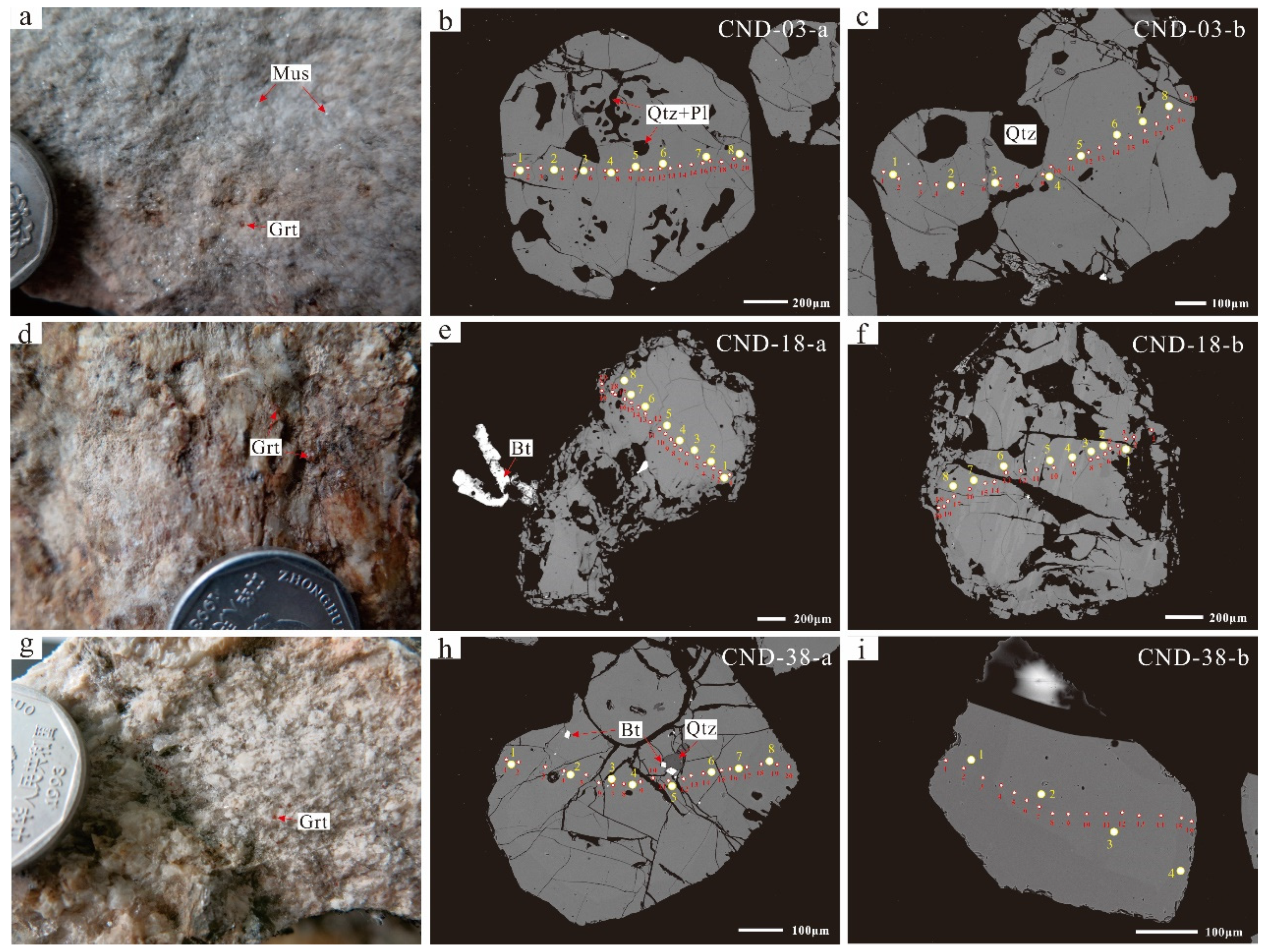
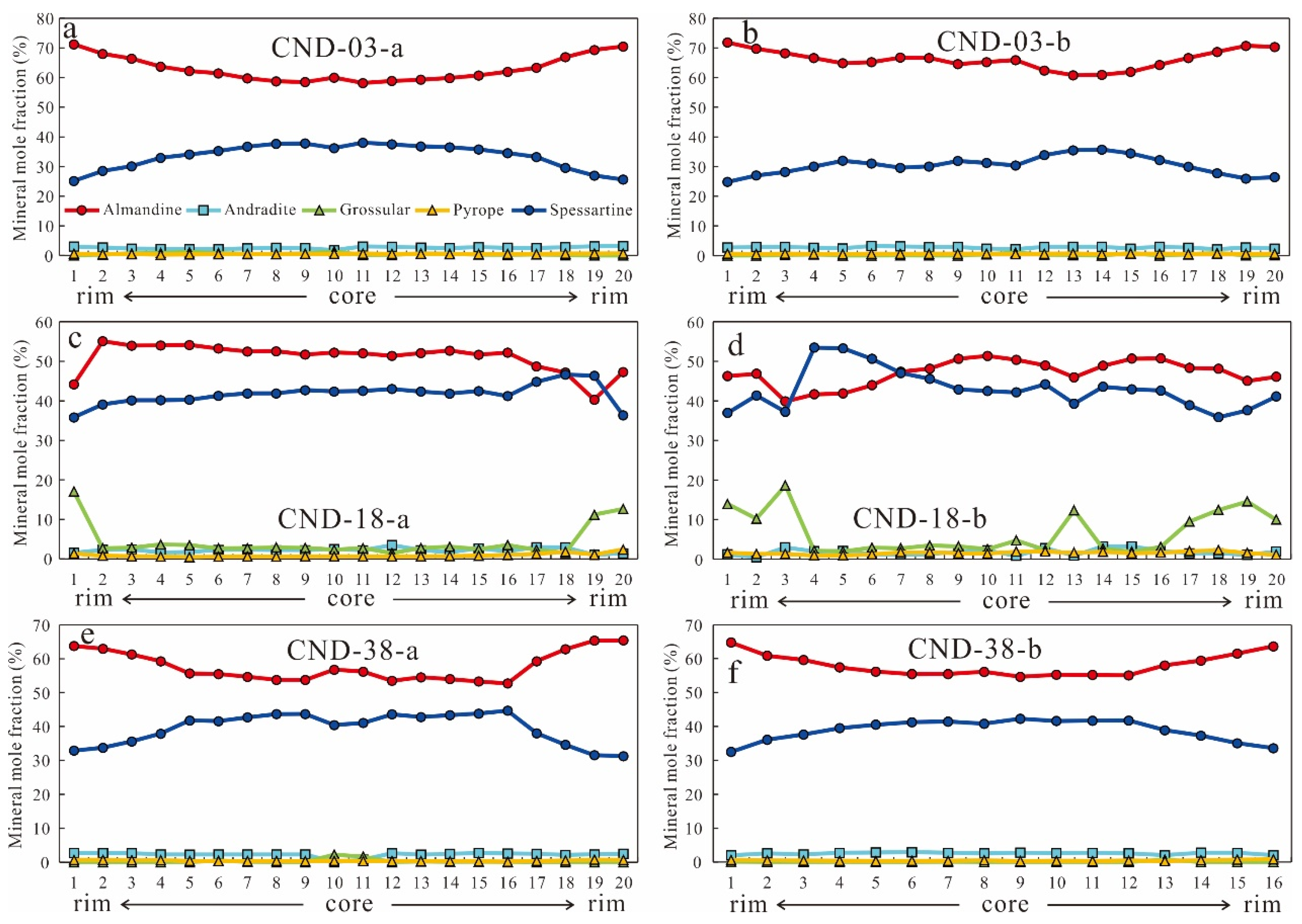
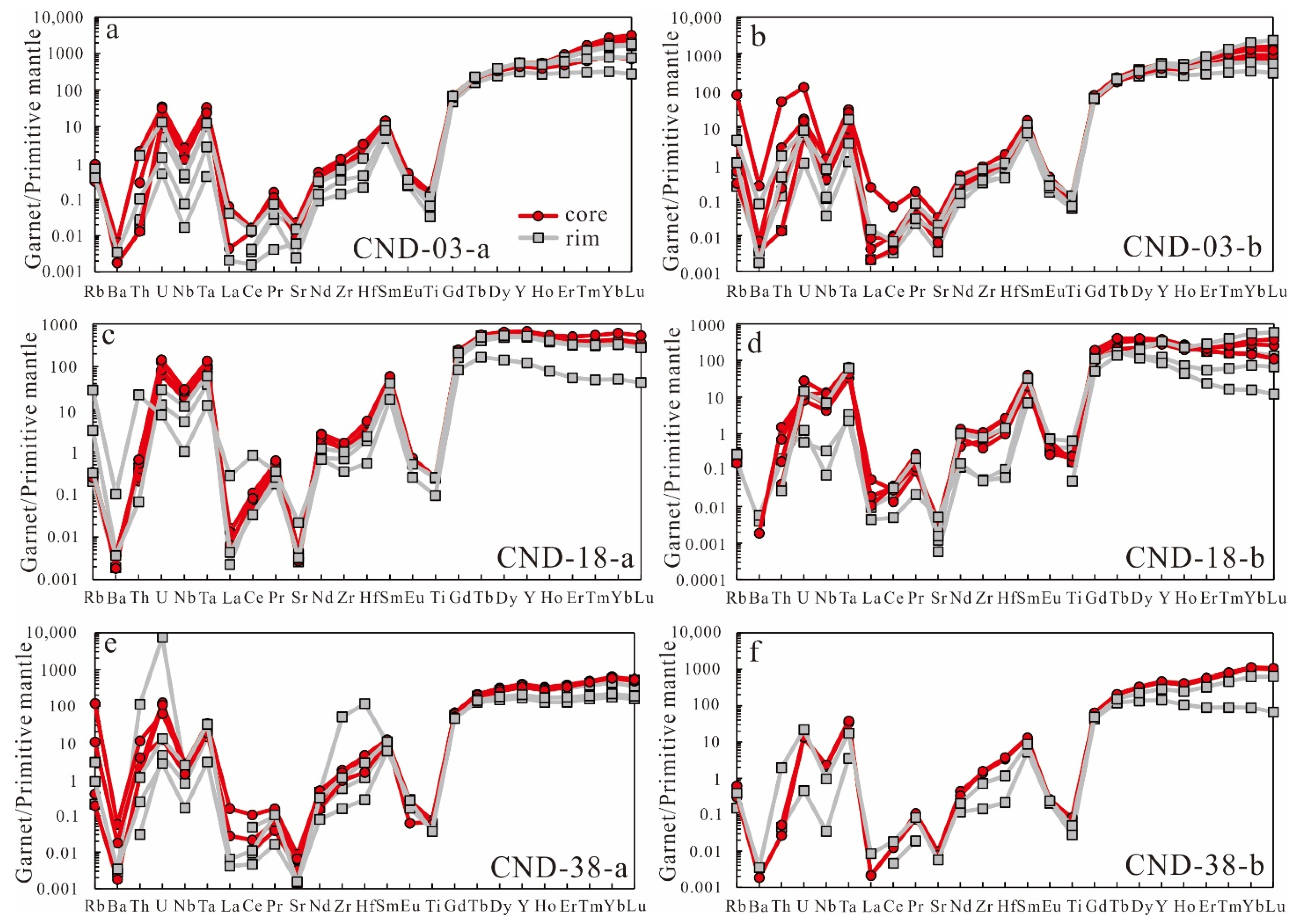
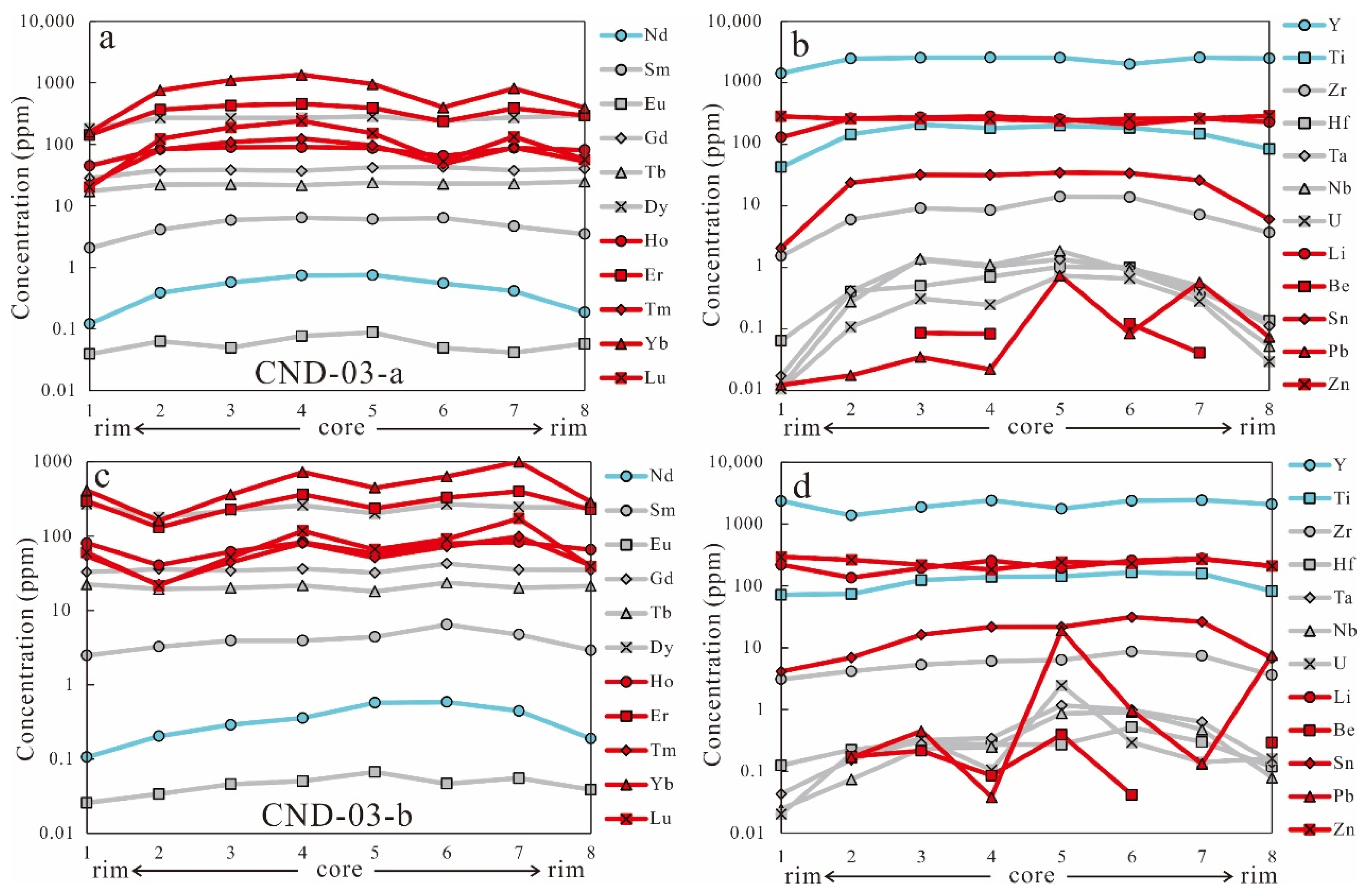
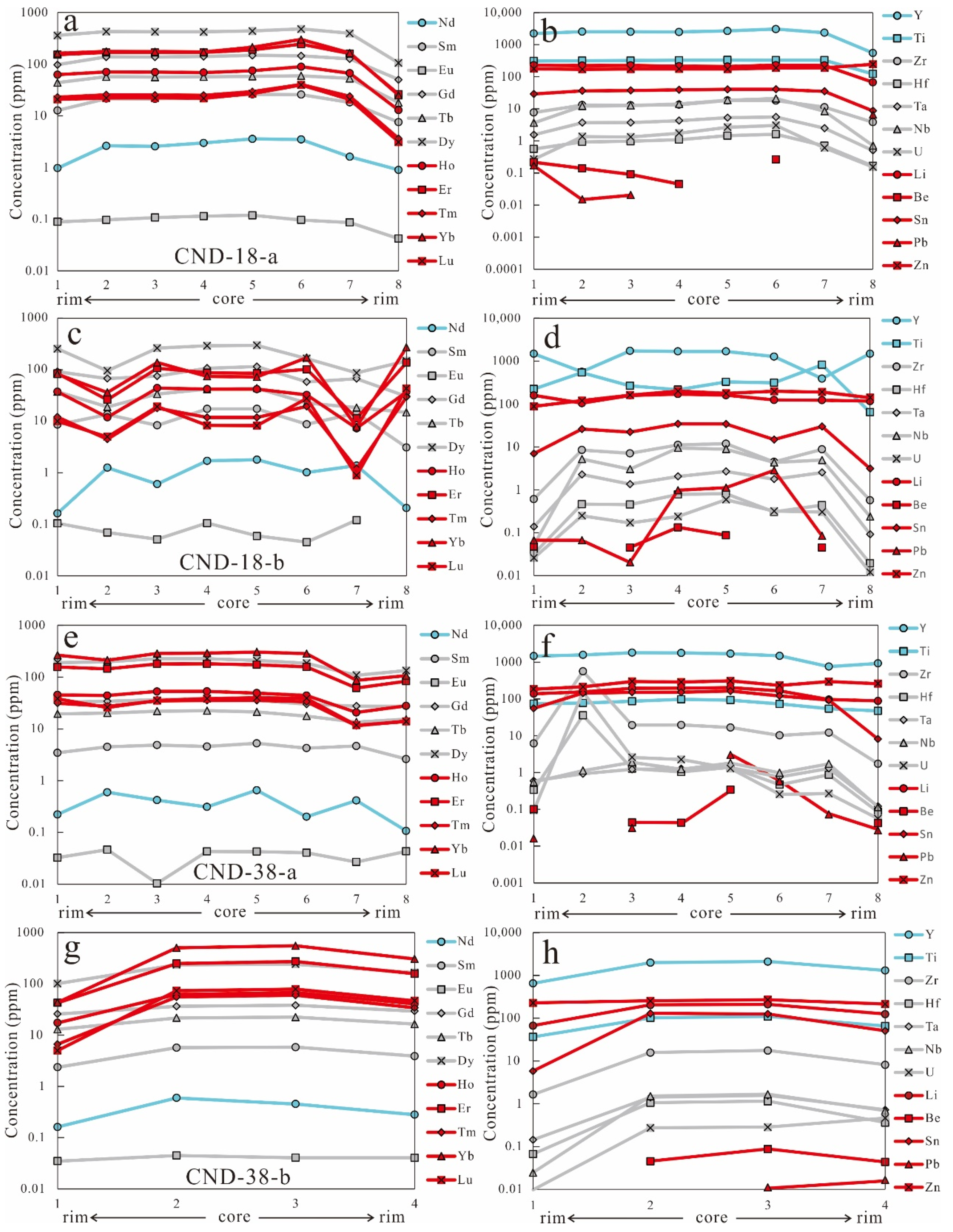



Publisher’s Note: MDPI stays neutral with regard to jurisdictional claims in published maps and institutional affiliations. |
© 2022 by the authors. Licensee MDPI, Basel, Switzerland. This article is an open access article distributed under the terms and conditions of the Creative Commons Attribution (CC BY) license (https://creativecommons.org/licenses/by/4.0/).
Share and Cite
Yan, H.; Yu, D.; Wang, S.; Ma, C. Magmatic Garnet and Magma Evolution in Cuonadong Leucogranites: Constraints from Petrology and Mineral Geochemistry. Minerals 2022, 12, 1275. https://doi.org/10.3390/min12101275
Yan H, Yu D, Wang S, Ma C. Magmatic Garnet and Magma Evolution in Cuonadong Leucogranites: Constraints from Petrology and Mineral Geochemistry. Minerals. 2022; 12(10):1275. https://doi.org/10.3390/min12101275
Chicago/Turabian StyleYan, Haibo, Deshui Yu, Shoujing Wang, and Chi Ma. 2022. "Magmatic Garnet and Magma Evolution in Cuonadong Leucogranites: Constraints from Petrology and Mineral Geochemistry" Minerals 12, no. 10: 1275. https://doi.org/10.3390/min12101275
APA StyleYan, H., Yu, D., Wang, S., & Ma, C. (2022). Magmatic Garnet and Magma Evolution in Cuonadong Leucogranites: Constraints from Petrology and Mineral Geochemistry. Minerals, 12(10), 1275. https://doi.org/10.3390/min12101275




